Power supply noise can come in more than one form. It could be switching noise from a switching regulator or switched mode power supply or noise from a linear regulator. While switching noise is to be expected, linear regulators are often assumed to be “quiet” but they may not be as quiet as you think. How big an impact that will have on your application depends on your circuitry. A digital circuit should be fairly immune to power supply noise including switching noise. However, the effect on analog circuitry could be very significant. For example, for the Linear Technology LT8609 switching regulator running at 2MHz and producing a 5V output with 22uF output capacitor, the peak to peak output noise will be over 3mV.
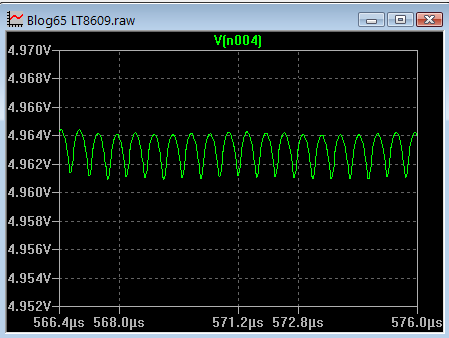
While the headline power supply rejection ratio (PSRR) for an opamp may be 80dB or 100dB, these are often quoted at a conveniently low frequency such as 1kHz. If you look at higher frequencies you will find it is not so good. For example, the AD8651 PSRR looks like this:
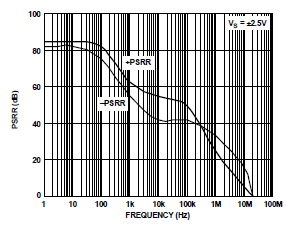
So at 2MHz the PSSR is not great – less than 20dB. 3mV of power supply noise at 2MHz is going to result in over 300µV on the opamp output compared to the opamp equivalent input noise of around 1.4µV over the same bandwidth. If you are amplifying a low level signal with multiple stages then the 300µV figure could then be amplified by another gain stage.
Linear regulators are a lot better than switching regulators for output noise but some are better than others. Also, the noise is broadband rather than concentrated at a specific frequency which can be better. The ubiquitous 7805 regulator has around 42µV of noise from 10Hz to 100kHz (Fairchild Semiconductor data). This is considerably lower than the noise you would get from a switching regulator but you could do better. The Analog Devices ADM7151 has output noise of only 1.6µV RMS from 10Hz to 100kHz. It is described as an RF regulator because discrete RF circuitry can be sensitive to power supply noise, often having 0dB of PSRR. Quoting the noise from 10Hz to 100kHz is a little strange for an RF regulator, although it makes comparison easier and is in fact the worst part of the power supply noise. From 10kHz upwards the noise plateaus at around 1.7nV/ÖHz. The noise in the lower frequency range (1Hz – 10kHz) is quite dependent on the bypass capacitance, as you can see below.
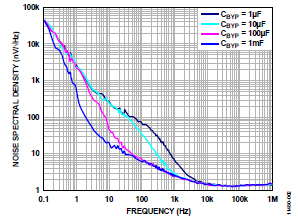
In RF circuitry the PSRR can almost non-existent and many RF ICs simply do not quote a figure for PSRR. A double balanced mixer for example, such as the one shown below, will have a PSRR of less than 2dB depending on the exact component values. So low power supply noise is important.
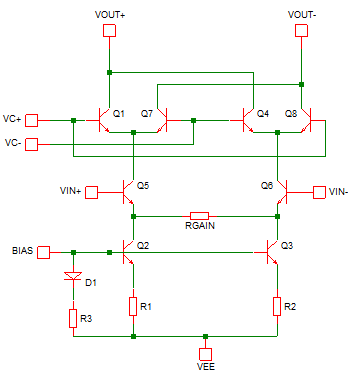
If you must have a switching regulator, for example where a high current supply is shared with less sensitive circuitry, you could still use a linear regulator as well to clean up the power supply for more sensitive circuitry. Regulator ICs such as the ADM7151 have reasonable line rejection although it does depend on the headroom and load current. Another option is to heavily filter a switching regulator. For example, adding 1µH of inductance and an additional 22µF of output capacitance to the LT8609 would reduce the 2MHz switching frequency from 3mV peak to around 1µV but the resonance caused by the inductor/capacitor combination will result in around 300µV at 30kHz to 40kHz. Trying to damp the inductor/capacitor resonance reduces the effectiveness of the additional filtering.
For analog designs I am still a fan of using some linear regulation where necessary. The Maxim MAX710 is an integrated solution to that problem, combining a switching regulator and LDO in the same package. It can be run in high efficiency mode where only the switching regulator is used, or low noise mode where the switching regulator generates a voltage 0.5V higher than the output voltage and the linear regulator drops that voltage and produces a cleaner output voltage. You can achieve the same effect with two separate ICs – a switching regulator and linear regulator. Even a cheap, “noisy” linear regulator combined with a switching regulator will most likely result in lower output noise than the switching regulator alone although you do need to check the line/ripple rejection of the linear regulator at high frequencies – a lot of them tend to only show performance up to 100kHz. Also, it does mean you need to generate a voltage from your switching regulator higher than you need so 5.5V for a 5V supply after linear regulation, for example.

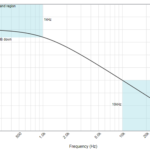


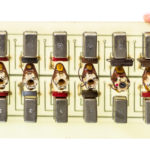
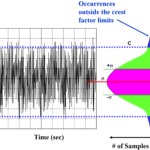

Leave a Reply
You must be logged in to post a comment.